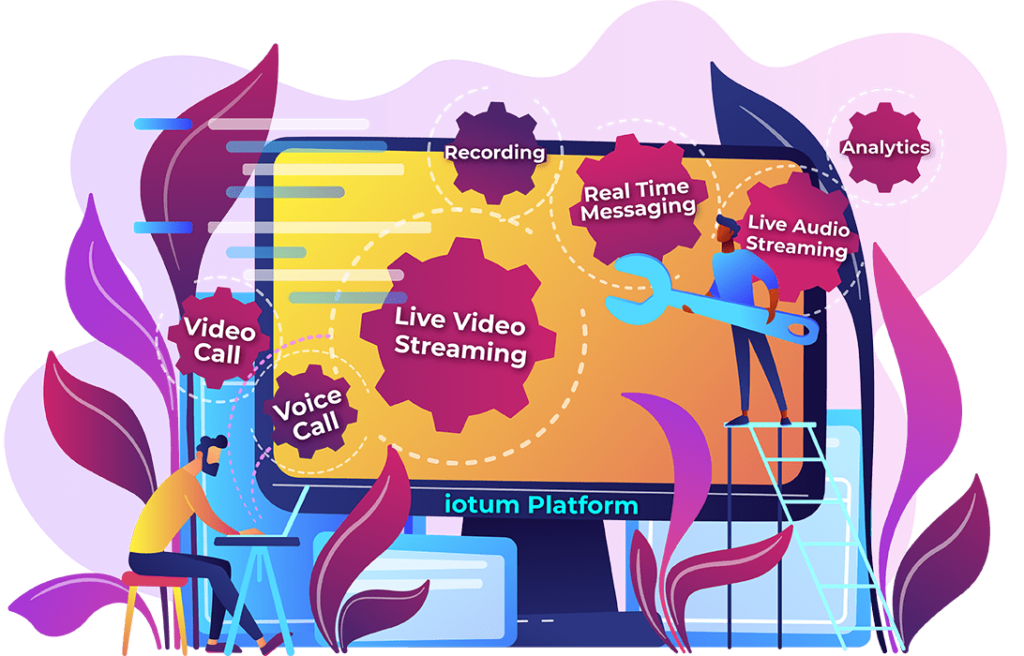 If you’re a lawyer or work in the legal industry, there’s no underestimating the power of succinct communication. Whether between colleagues or managing client-lawyer relationships; discussing solutions or managing conflicts – the way in which you quite literally present your side of the story can be the difference between success and failure.
If you’re a lawyer or work in the legal industry, there’s no underestimating the power of succinct communication. Whether between colleagues or managing client-lawyer relationships; discussing solutions or managing conflicts – the way in which you quite literally present your side of the story can be the difference between success and failure.
Setting the tone starts with sending and receiving messages that are crystal clear. Not long ago, law firms relied heavily on conference calls as the preferred mode of communication. However, as video conferencing presents more benefits that lead to better productivity, increased cost savings, employee happiness and safety, and better client retention, firms are relying on two-way communication technology to engage business.
The benefits of video conferencing are many. What was once thought of as futuristic and could cost up to tens of thousands of dollars, nowadays, this tech is required to run a business – and doesn’t cost nearly as much. Plus, the software has been significantly refined, and sophisticated. It’s intuitive to use, implement and share.
If you’re a law firm looking to:
- Be more immediate with the transmission of information, data, and support for a client
- Strengthen corporate culture and internal communication
- Improve and streamline complicated billing and administration tasks
- Zone in and focus on client meetings without static, dropped calls or distraction
- Manage the versatility of a call locally or overseas
Then look into video conferencing as part of your business strategy. Keep in mind the following questions that will help you decide which platform is best for your firm’s needs.
First things first. There is nothing unproductive about conference calls. In fact, they’re extremely effective for a variety of uses. This post isn’t about replacing conference calls with video conferencing. It’s merely to show that by utilizing both, you can provide more value to go deeper with clients.
Conference calling is excellent for:
- Having impromptu or scheduled discussions regarding a development in the case
- Cutting down long email threads to get straight to point
- Specialization and sharing information about specific topics
- Getting decision-makers in the same space
- Enabling conference transcription and recording for further breaking down information
Add in the next dimension that video conferencing provides, and you’ll see how more well-rounded your offerings are not only for your clients, but also with colleagues in the office, and superiors. HR, IT, and other departments benefit greatly as well.
What does video conferencing provide?
Client communication is at the forefront of the success of every law firm.
At the end of the day, it comes down to:
1) building trust in a client and
2) then maintaining it.
These two critical steps are the foundation for providing excellent communication with clients that:
- Caters to their needs and delivers positive client experiences by making them feel like a priority, positioning you as an advocate for their cause.
- Builds your reputation. In an industry where word of mouth is worth as much as gold, your law firm’s reputation is your calling card. Most law firms are vying for business based on their experience.
- Want to stand out? Approach your client communication strategy with state-of-the-art tools and methods that bring you the key insights you need to understand each other.
- Creates harmony between you and your client. Ongoing communication at every touchpoint of the process works to avoid anything from being swept under the rug or not brought up.
Especially at the beginning when the client is just trying to figure out if they like you as an attorney and want to hire you, while at the same time, you’re trying to assess if they have a legal problem you can help them solve.
 It’s so critical to lay a foundation of proper communication from the get-go. Don’t let subpar communication methods, poor relationship management, and improper use of time affect how your clients are handled.
It’s so critical to lay a foundation of proper communication from the get-go. Don’t let subpar communication methods, poor relationship management, and improper use of time affect how your clients are handled.
Instead, add into the mix video conferencing that comes with these 3 key benefits:
Key Benefit #1
High-security standards throughout the duration of the call.
Keeping your client’s information safe and secure is a top priority for every legal practitioner. Online meetings whether short or extended should be equipped with all the necessary best-in-practice steps towards proper security measures:
- Mandatory to provide access to a secure conference call
- Must be able to control participants in a call
- Add extra layers of security if need be (Meeting Lock, One-Time Access Code, Etc.)
- Guarantee that the participants on the call are the ONLY participants on the call
- Conference call portal
Key Benefit #2
Easy transmission of sending and receiving information.
When dealing with clients, it’s important to provide easy-to-use, intuitively designed communication technology that helps more than hinders. A platform that is user-friendly and can be customized to reflect your brand proves to be a more pleasant experience.
Furthermore, opt for a platform loaded with features that support your conversation like:
- Screen sharing for poring over documents and files in real-time online. By sharing your desktop, you can include other participants to view and see exactly what you’re seeing. Every course of action is made “viewable” for more enhanced collaboration, heightened communication and accelerated participation. Screen sharing makes any chat more dynamic and easier to facilitate.
- Meeting recordings for accurate recounting of past events, details and history. Used during a video conference (or conference call), a recording provides a bigger picture of what’s going on. Especially when asking some tough questions, recording a meeting might prove to be beneficial down the road when reviewing for more details as a person’s body language, nuances and tone of voice come through more clearly via video.
- Video and audio recordings also work very well if someone can’t attend or watch now as they can view it later, instead.
- AI transcriptions help you and your team to be present and hold space rather than dividing your attention between taking notes and listening. With detailed transcriptions done for you to include speaker tags, and time and date stamps, you can carry on with a testimony or other video-based communication without worrying whether or not information was caught. Dates, names, places and common themes and topics are all filtered and recorded for easy recall and more in-depth data post-conference.
The detailed info that’s laid out with speaker tags, date stamps, and easy-to-read speech to text notes saves you time. This is especially helpful for testimonials, or other judicial processes including warrants, etc.
Key Benefit #3
Access to all the acquired information after the call is complete.
It’s especially important and beneficial for video conferencing technology to provide call summaries and transcriptions organized at the end of the sync. Post-conference data that is tagged and is as easy to search through as your email makes your job easier and more efficient. Plus, all information including sent links, media, videos and recordings, plus files and documents gets saved to the cloud for a more centralized, easy access navigation path that you and anyone on your team or in your firm can access.
A summary of the video call that has everything in one place makes the sharing of information more smooth and seamless. Nothing falls between the cracks when everything is laid out before you.
Now that the benefits are a little more obvious, it’s more clear how implementing video conferencing into your everyday can greatly impact the quality of your communication. Watch how the flow of things becomes more streamlined when everyone is connected. Clients want to know you’re taking care of their needs and employees want to feel like their upper management has faith in them.
As you’re considering video conferencing solutions for your law firm, here are 6 questions you need to ask first:
6. How will you be incorporating video conferencing into your practice?
Where is your firm in relation to police stations, hospitals, courthouses, detention centers, etc? Do these places allow for video submissions and other forms of communication for legal procedures? How tech-savvy is your clientele?
 5. How often do you plan to schedule video conferences?
5. How often do you plan to schedule video conferences?
Take note of the size of your firm and what the future has in store for growth. Furthermore, will other departments jump on the bandwagon as well? This is an excellent opportunity for HR to keep in touch with other firms and hire internationally.
4. Will you use video conferencing for additional training and webinars?
For law practitioners who want to improve their skill set; For connecting partners and sister law firms; becoming a mentor or training IT – utilizing video conferencing is an efficient, cost-effective way of using technology to empower people in their role.
HR can use video conferencing solutions to expedite and improve recruitment and the hiring process by opening up the talent pool overseas. IT is able to quickly address any tech problems and offer support via text chats plus with the help screen sharing and video chat, offer complicated guidance, navigation and set up – anywhere, at any time.
3. How many lawyers and clients are willing to use this technology?
Consider how your team operates by discussing the features and benefits of a more video-centric communications strategy. Will this empower work-life balance? Can attorneys work from home some days? This applies to clients as well. Are they responsive to potentially more virtual facetime? Will implementing a more online approach to meetings and lawyer-client relationships save travel time and improve productivity?
2. What ROI can you expect?
Dive into what the approximate extent of use will be. With a quick calculation, compare and contrast the current amount of time being spent on certain instances between travel time and resources. Add it up to figure out the hours of time per month, and see how implementing video conferencing might make a difference.
1. How streamlined is the technology you’re looking at?
Investigate how two-way communication software can integrate with your existing infrastructure and how that can impact your workflow. Look for something that simplifies processes; is easy for everyone to use; connects to the remote virtual workforce and offers applications and features that provide value and more meaningful interactions.
Follow up questions to ponder:
• What security features are included?
• How many participants are accommodated?
• Is there customer support?
• What features are included? Is there recording? Screen sharing? Summaries?
• What’s the mobile experience like? Is there an app?
By combining both conference calling and video conferencing into your every day: from internal meetings, to employee onboarding and continued learning, to virtual depositions and more, it becomes obvious that in order to move with the times, law firms have to embrace going digital.
Online offerings open the doors for more business, productivity and enhanced trust and accessibility with clients. Heightened communication makes everyone’s role – separate or as a whole – more effective.
Let Callbridge provide your law firm with best-in-class sophisticated conferencing that builds an empowered culture of communication within your immediate team and office while shining a light on how to manage and nurture client relationships.
Providing a two-way communication platform to encourage clear and concise communication inside and outside of the courtroom starts with technology that is designed to bridge the gap between meetings held in person and online.
Callbridge’s suit of digital services works to:
- Keep employees and clients informed with easy transmission and accessibility of information
- Maintain a private and secure connection at all times
- Simplify and connect with features like AI transcription, Meeting Recording and Screen Sharing that enhance productivity, efficiency and participation
- Encourage more face time in real time with high quality video and audio conferencing
- And more!
Find out how Callbridge video conferencing solutions can give your firm a competitive advantage by leveraging the work that gets done and how clients are taken care of.


